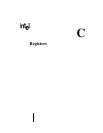
8XC196NP, 80C196NU USER’S MANUAL
B-8
EA# (NP only) I External Access
This input determines whether memory accesses to special-purpose and
program memory partitions (FF2000–FF2FFFH) are directed to internal or
external memory. These accesses are directed to internal memory if EA# is
held high and to external memory if EA# is held low. For an access to any other
memory location, the value of EA# is irrelevant.
EA# is not latched and can be switched dynamically during normal operating
mode. Be sure to thoroughly consider the issues, such as different access times
for internal and external memory, before using this dynamic switching capability.
On devices with no internal nonvolatile memory, always connect EA# to V
SS
.
EA# is not implemented on the 80C196NU.
EPA3:0 I/O Event Processor Array (EPA) Input/Output pins
These are the high-speed input/output pins for the EPA capture/compare
channels. For high-speed PWM applications, the outputs of two EPA channels
(either EPA0 and EPA1 or EPA2 and EPA3) can be remapped to produce a
PWM waveform on a shared output pin (see “Generating a High-speed PWM
Output” on page 10-14).
EPA3:0 are multiplexed with P1.3:0.
EPORT.3:0 I/O Extended Addressing Port
On the 8XC196NP, this is a 4-bit, bidirectional, memory-mapped I/O port.
On the 8XC196NU, this is a 4-bit, bidirectional, standard I/O port.
EPORT.3:0 are multiplexed with A19:16.
EXTINT3:0 I External Interrupts
In normal operating mode, a rising edge on EXTINT
x
sets the EXTINT
x
interrupt pending bit. EXTINT
x
is sampled during phase 2 (CLKOUT high). The
minimum high time is one state time.
In standby and powerdown modes, asserting the EXTINT
x
signal for at least 50
ns causes the device to resume normal operation. The interrupt need not be
enabled, but the pin must be configured as a special-function input (see
“Bidirectional Port Pin Configurations” on page 7-7). If the EXTINT
x
interrupt is
enabled, the CPU executes the interrupt service routine. Otherwise, the CPU
executes the instruction that immediately follows the command that invoked the
power-saving mode.
In idle mode, asserting any enabled interrupt causes the device to resume
normal operation.
EXTINT0 is multiplexed with P2.2, EXTINT1 is multiplexed with P2.4, EXTINT2
is multiplexed with P3.6, and EXTINT3 is multiplexed with P3.7.
HLDA# O Bus Hold Acknowledge
This active-low output indicates that the CPU has released the bus as the result
of an external device asserting HOLD#.
HLDA# is multiplexed with P2.6.
Table B-3. Signal Descriptions (Continued)
Name Type Description


















